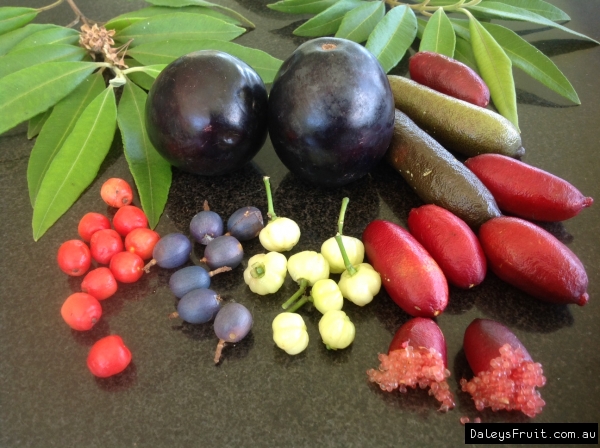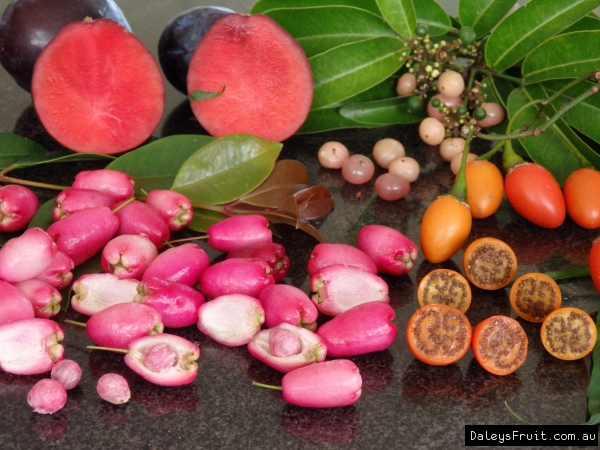Bush foods Australia
CategoryFinger Lime
Fruit Trees > Bush foods Australia > Finger Lime
Fruit Trees > Citrus Trees > Finger Lime
A delicate rainforest tree that naturally occurs as an understorey tree in SE Queensland and Northern NSW Australia. Finger Lime trees are erect trees growing up to 10 metres.
Lilly Pilly
Fruit Trees > Bush foods Australia > Lilly Pilly
Australia boasts over 60 different varieties of lilly pillies all of which appear to be edible. They range from a small bush to a large tree and are well respected for their spectacular ornamental qualities. Their tastes vary quite markedly but all have a high pectin content and are well suited to preserving. The trees make excellent screens, windbreaks, bird attractants or garden ornamentals.
Macadamia Nut Tree
Fruit Trees > Bush foods Australia > Macadamia Nut Tree
Fruit Trees > Nut Trees > Macadamia Nut Tree
It isn't any wonder that the macadamia nut tree from Australia is regarded as the best quality nut in the world. The nuts are sweet and can be enjoyed eaten raw, roasted, fried, chocolate coated, candied, made into nut butters, biscuits, cakes and pies. They have a great crunchy texture. The two edible species M. tetraphylla (Northern NSW) and M. integrifolia(S.E. Qld) make up most of the commercial varieties below. Warning: Macadamia kernels are poisonous to dogs, even sometimes in small amounts, so keep them away from your canine friends.
Sandpaper Fig
Fruit Trees > Bush foods Australia > Sandpaper Fig
This small fig occurs along watercourses along the east coast of Australia. An attractive small tree with sandpapery leaves and edible fruit. Grows densely in full sun, less so in shade. Very good for stream bank stablilisation. The small figs are a tasty bush food and the leaves were used by Indigenour Australians to finish off their wooden tool.
Lilly Pilly - Rain Cherry
$18.75 ($4.90-$18.75 choose a size)
Friday
Lime - Australian Desert 'Standout' PBR
$89.00
Friday
Lime - Australian Desert Abundance PBR
$89.00
Cape York Turmeric
$24.00 ($19.75-$24.00 choose a size)
Friday
Noni Fruit
$49.00 ($24.00-$49.00 choose a size)
Friday
Cinnamon Myrtle
$14.90 ($14.90-$19.90 choose a size)
Midyim Berry- Blush
$19.90 ($19.90-$23.90 choose a size)
Winter Apple
$17.90 ($4.90-$17.90 choose a size)
Pigface
$14.90
Orange Berry
$18.75 ($17.90-$29.00 choose a size)
Atherton Oak
$19.75
Native Currant
$19.90 ($4.90-$19.90 choose a size)
Australian Round Lime
$49.00 ($29.00-$49.00 choose a size)
Cape Gooseberry
$19.75 ($18.75-$19.75 choose a size)
North Bauple Nut
$19.75
Friday
Kurrajong
$3.90 ($3.90-$16.90 choose a size)
Native Nutmeg
$39.00
Palm - Walking Stick
$17.90 ($4.90-$24.75 choose a size)
Native Leek
$15.90
Raspberry - Atherton
$19.75 ($19.75-$23.90 choose a size)
Ruby Saltbush
$9.75
Kakadu Plum - Grafted
$120.00
(Discontinued) Native Raspberry - Peter's Thornless PBR
$34.95 ($29.90-$34.95 choose a size)
Lemon Myrtle
$18.75 ($18.75-$34.00 choose a size)
Midyim - Copper Tops
$23.90 ($18.75-$23.90 choose a size)
Finger Lime - Rosebank Red
$24.00 ($24.00-$49.00 choose a size)
Dwarf Finger Lime - Pink
$69.00
Quandong - Desert
$59.00
Aspen - Lemon
$29.00 ($29.00-$39.00 choose a size)
Eucalyptus - Strawberry Gum
$21.00 ($9.75-$21.00 choose a size)
Finger Lime - Rosebank Purple
$24.00 ($24.00-$59.00 choose a size)
Mountain Pepper- Female
$29.00
Muntries
$29.00
Burdekin Plum
$4.90 ($4.90-$19.75 choose a size)
Mountain Pepper - Male
$24.00
Sandalwood - Australian
$27.00 ($19.90-$27.00 choose a size)
Murnong
$21.90 ($4.90-$21.90 choose a size)
Native Pink Hibiscus
$18.75 ($4.90-$18.75 choose a size)
Native Lemongrass
$18.75
Mount White Lime
$69.00 ($49.00-$69.00 choose a size)
Peanut Tree
$4.90 ($4.90-$23.90 choose a size)
Chocolate Lily
$19.90 ($19.75-$19.90 choose a size)
Palm - Fan
$19.90 ($19.90-$19.90 choose a size)
Finger Lime - Green Beauty
$29.00 ($29.00-$49.00 choose a size)
Fraser Island Apple
$17.90
Bush Tomato
$19.90
Warrigal Greens - Native Spinach
$14.90 ($7.90-$14.90 choose a size)
Small Leaf Tamarind
$19.75 ($4.90-$24.00 choose a size)
Bunya Nut
$4.90 ($4.90-$29.00 choose a size)
White Kunzea
$17.90
Cedar Bay Cherry
$19.75 ($19.75-$19.75 choose a size)
Pandanus - Native Screw Pine
$29.90 ($17.75-$29.90 choose a size)
Dwarf Plum Pine
$21.90 ($17.75-$21.90 choose a size)
Wild Orange
$19.75 ($19.75-$24.00 choose a size)
Singleton Mint Bush
$21.90
Curry Myrtle
$19.90
Wattle - Raspberry Jam
$19.90
Kurrajong - Desert
$23.90
Native Currant - Black
$19.90 ($4.90-$19.90 choose a size)
Plum Pine - Female Cutting
$19.90
Little Gooseberry Tree
$19.90
Native Ginger - Wavy Leaf
$4.90
Native Wampee - Gregs
$14.75 ($4.95-$14.90 choose a size)
Johnstone River Almond
$19.75
Bottle Tree - Broad-leaved
$14.90 ($4.90-$14.90 choose a size)
Kangaroo Apple
$4.90
Zig Zag Vine
$19.90
Native Rosella
$4.90 ($4.90-$14.75 choose a size)
Candle Nut
$24.00 ($14.90-$29.00 choose a size)
Climbing Pandan
$19.90
Millaa Millaa Vine
$19.90
Black Plum
$4.90 ($4.90-$18.75 choose a size)
Wattle - Bramble
$4.90
Kangaroo Grass
$4.90
Popular in Category: Bush foods Australia
Macadamia Pinkalicious TM
$49.00
Friday
Lilly Pilly - Riberry
$19.90 ($3.75-$19.90 choose a size)
Lilly Pilly - Rain Cherry
$18.75 ($4.90-$18.75 choose a size)
Finger Lime - Red
$69.00 ($34.00-$149.00 choose a size)
Friday
Lilly Pilly - Broad-leaved
$12.75 ($4.90-$18.75 choose a size)
Friday
Lime - Australian Desert 'Standout' PBR
$89.00
Midyim Berry
$14.90 ($4.90-$19.75 choose a size)
Friday
Lime - Australian Desert Abundance PBR
$89.00
Dwarf Macadamia - A16
$49.00 ($19.75-$59.00 choose a size)
Finger Lime
$19.90 ($4.90-$19.90 choose a size)
Customer Tips & Reviews Bush foods Australia
Krawarree, New South Wales, Australia
Bush foods Australia
Hi....what a wonderful summary of Australian fruits and nuts. Best I've seen
Roseneath, Queensland, Australia, Australia
Bush foods Australia
Wow couldnt wait to share this site it is just so inspiring










































































































































































